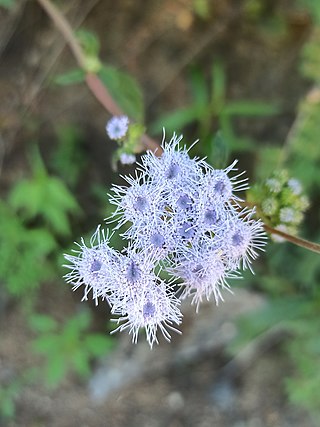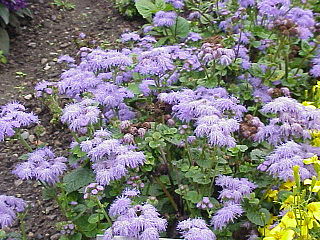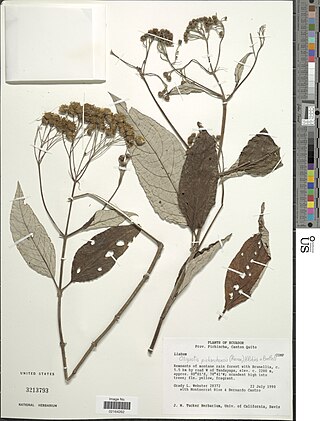
Ageratina, commonly known as snakeroot, is a genus of more than 330 perennials and rounded shrubs in the family Asteraceae.

Ageratum is a genus of 40 to 60 tropical and warm temperate flowering annuals and perennials from the family Asteraceae, tribe Eupatorieae. Most species are native to Central America and Mexico but four are native to the United States.

Eupatorieae is a tribe of over 2000 species of plants in the family Asteraceae. Most of the species are native to tropical, subtropical, and warm temperate areas of the Americas, but some are found elsewhere. Well-known members are Stevia rebaudiana, a number of medicinal plants (Eupatorium), and a variety of late summer to autumn blooming garden flowers, including Ageratum (flossflower), Conoclinium (mistflower), and Liatris.
Aetheolaena cuencana is a species of flowering plant in the family Asteraceae. It is found only in Ecuador. Its natural habitats are subtropical or tropical moist montane forests and subtropical or tropical high-altitude shrubland. It is threatened by habitat loss.
Ageratina dendroides is a species of flowering plants in the family Asteraceae. It is found only in Ecuador. Its natural habitats are subtropical or tropical moist montane forests and subtropical or tropical high-altitude grassland. It is threatened by habitat loss.
Ageratina macbridei is a species of flowering plant in the family Asteraceae. It is endemic to Peru, where it occurs in several types of habitats, often near rivers.
Ageratina rhypodes is a species of flowering plant in the family Asteraceae. It is found only in Ecuador. Its natural habitats are subtropical or tropical moist montane forests and subtropical or tropical high-altitude grassland. It is threatened by habitat loss.
Ageratina sodiroi is a species of flowering plant in the family Asteraceae. It is endemic to Ecuador, where it is widely distributed in the Andes.

Critonia is a genus of flowering plants in the tribe Eupatorieae of the family Asteraceae.
Fleischmannia obscurifolia is a species of flowering plant in the family Asteraceae. It is found in Ecuador and Colombia. Its natural habitats are subtropical or tropical moist lowland forests and subtropical or tropical moist montane forests. It is threatened by habitat loss.
Idiopappus is a monotypic genus of flowering plant in the family Asteraceae. Its only species is Idiopappus saloyensis, endemic to Ecuador. Its natural habitat is subtropical or tropical high-altitude grassland. It is threatened by habitat loss.
Mikania cuencana is a species of flowering plant in the family Asteraceae. It is found only in Ecuador. Its natural habitat is subtropical or tropical moist montane forests. It is threatened by habitat loss.

Sampera asplundii is a species of flowering plant in the family Asteraceae. It is found only in Ecuador and it is threatened by habitat loss. Its natural habitat is subtropical or tropical moist montane forests.
Gregbrownia brownii, synonym Mezobromelia brownii, is a species of flowering plant in the family Bromeliaceae. It is endemic to Ecuador. Its natural habitats are subtropical or tropical moist montane forests and subtropical or tropical high-altitude shrubland. It is threatened by habitat loss.
Pitcairnia harrylutheri is a species of flowering plant in the family Bromeliaceae, endemic to Ecuador. It was first described by Harry Edward Luther in 1991 as Pepinia fulgens. When transferred to the genus Pitcairnia in 1999, the epithet had to be changed, as the name Pitcairnia fulgens had already been used. Pitcairnia harrylutheri is a replacement name. The natural habitats of the species are subtropical or tropical moist lowland forests and subtropical or tropical moist montane forests. It is threatened by habitat loss.
Pitcairnia elvirae, synonym Pepinia verrucosa, is a species of flowering plant in the family Bromeliaceae, endemic to Ecuador. It was first described in 1999. Its natural habitats are subtropical or tropical moist lowland forests and subtropical or tropical moist montane forests. It is threatened by habitat loss.
Tillandsia marnieri-lapostollei is a species of flowering plant in the family Bromeliaceae. It is endemic to Ecuador. Its natural habitat is subtropical or tropical dry forests. It is threatened by habitat loss.

Ageratina riparia, commonly known as mistflower, is a species of flowering plant in the family Asteraceae, native to Mexico. The species is widely adventive and has spread to Cuba, Jamaica, and other parts of the Caribbean. It has also been introduced as an ornamental plant and naturalized in a variety of regions, including parts of Hawaii, South Africa, Southeast Asia, Macaronesia, Oceania, Peru, and the Indian subcontinent. In tropical climates, A. riparia is highly invasive and a variety of control methods have been developed to reduce its spread.

Ageratina havanensis, the Havana snakeroot or white mistflower, is a species of flowering shrub in the family Asteraceae, native to the south-western United States (Texas), Cuba, and north-eastern and east-central Mexico. Unlike many other species of Ageratina, it is evergreen.
Ageratina lemmonii, called the Lemmon's snakeroot, is a North American species of plants in the family Asteraceae. It is found only in the southwestern United States in the states of Arizona and New Mexico, as well as the states of Sonora, Sinaloa, Chihuahua and Durango in Mexico.







